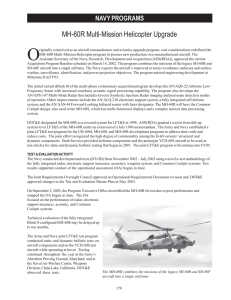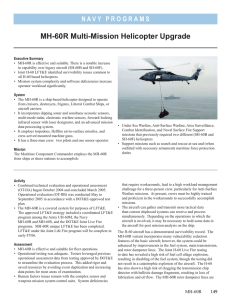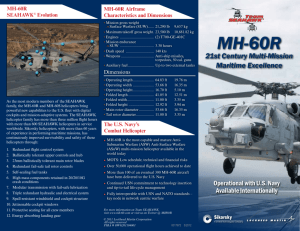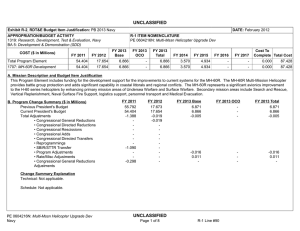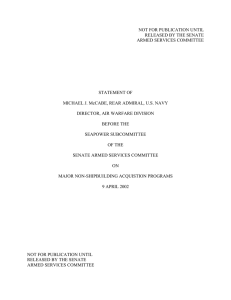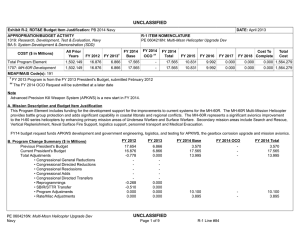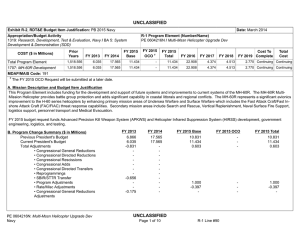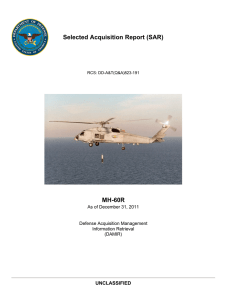MH-60R Multi-Mission Helicopter NAVY PROGRAMS
advertisement
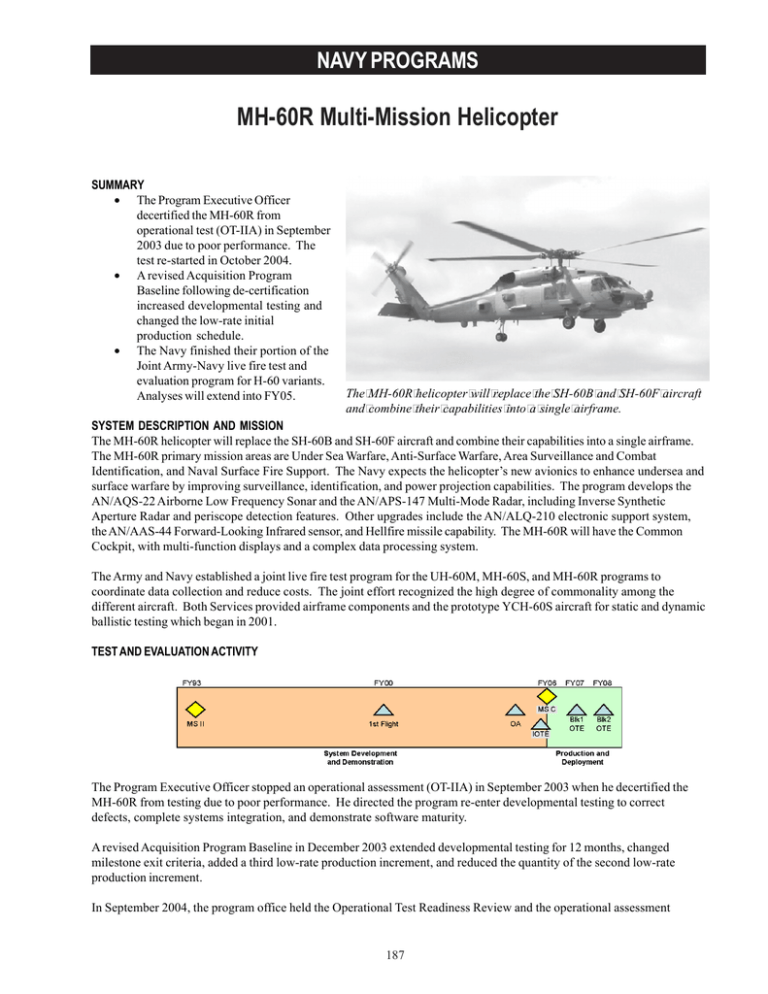
NAVY PROGRAMS MH-60R Multi-Mission Helicopter SUMMARY • The Program Executive Officer decertified the MH-60R from operational test (OT-IIA) in September 2003 due to poor performance. The test re-started in October 2004. • A revised Acquisition Program Baseline following de-certification increased developmental testing and changed the low-rate initial production schedule. • The Navy finished their portion of the Joint Army-Navy live fire test and evaluation program for H-60 variants. Analyses will extend into FY05. The MH-60R helicopter will replace the SH-60B and SH-60F aircraft and combine their capabilities into a single airframe. SYSTEM DESCRIPTION AND MISSION The MH-60R helicopter will replace the SH-60B and SH-60F aircraft and combine their capabilities into a single airframe. The MH-60R primary mission areas are Under Sea Warfare, Anti-Surface Warfare, Area Surveillance and Combat Identification, and Naval Surface Fire Support. The Navy expects the helicopter’s new avionics to enhance undersea and surface warfare by improving surveillance, identification, and power projection capabilities. The program develops the AN/AQS-22 Airborne Low Frequency Sonar and the AN/APS-147 Multi-Mode Radar, including Inverse Synthetic Aperture Radar and periscope detection features. Other upgrades include the AN/ALQ-210 electronic support system, the AN/AAS-44 Forward-Looking Infrared sensor, and Hellfire missile capability. The MH-60R will have the Common Cockpit, with multi-function displays and a complex data processing system. The Army and Navy established a joint live fire test program for the UH-60M, MH-60S, and MH-60R programs to coordinate data collection and reduce costs. The joint effort recognized the high degree of commonality among the different aircraft. Both Services provided airframe components and the prototype YCH-60S aircraft for static and dynamic ballistic testing which began in 2001. TEST AND EVALUATION ACTIVITY The Program Executive Officer stopped an operational assessment (OT-IIA) in September 2003 when he decertified the MH-60R from testing due to poor performance. He directed the program re-enter developmental testing to correct defects, complete systems integration, and demonstrate software maturity. A revised Acquisition Program Baseline in December 2003 extended developmental testing for 12 months, changed milestone exit criteria, added a third low-rate production increment, and reduced the quantity of the second low-rate production increment. In September 2004, the program office held the Operational Test Readiness Review and the operational assessment 187 NAVY PROGRAMS (OT-IIA) started over in October 2004. The MH-60R will undergo formal operational evaluation from May-September 2005. The Navy updated the Test and Evaluation Master Plan in August to reflect the new baseline and revise the test strategy. An administrative change to the Operational Requirements Document, which updates Electronic Warfare key performance parameters, is in staffing. We expect approval of the revised document prior to starting the formal operational evaluation. The Army and Navy joint Live Fire Test and Evaluation (LFT&E) test program continued both static and dynamic ballistic tests on aircraft components and on the YCH-60S test aircraft. Testing continued throughout the year at the Army’s Aberdeen Proving Grounds, Maryland, and at the Naval Air Warfare Center, Weapons Division, China Lake, California. This year’s effort completes the Navy portion of the joint tests on H-60 variants. Analytical efforts will extend into FY05. TEST AND EVALUATION ASSESSMENT The integration of the Common Cockpit and mission systems in the MH-60R has led to software instability problems. The program office and contractor have made a concerted effort to correct these deficiencies. Results of the ongoing operational assessment will provide greater insight on the stability of the updated software. Navy operational testers have only partially assessed the weapon system and Integrated Self Defense System because their integration wasn’t complete during previous test periods. To provide additional technical risk reduction and save time, the program office scheduled a combined operational assessment and technical evaluation period beginning in October 2004. However, there is only two months between the end of the combined test period and the start of the formal operational evaluation. This may not be enough time to correct deficiencies from the combined test period. Data from the Joint Army-Navy LFT&E Program, along with legacy H-60 databases, are adequate to evaluate survivability. They indicate the MH-60R will be survivable in its intended operational environment. The MH-60R is damage-tolerant and can withstand multiple small-arms projectile hits. It can continue to fly and often complete its mission in spite of the damage. Data collected since the program’s inception include nearly full-up tests of the fuel systems, drive system, rotor blades, and flight controls under realistic dynamic conditions. 188
